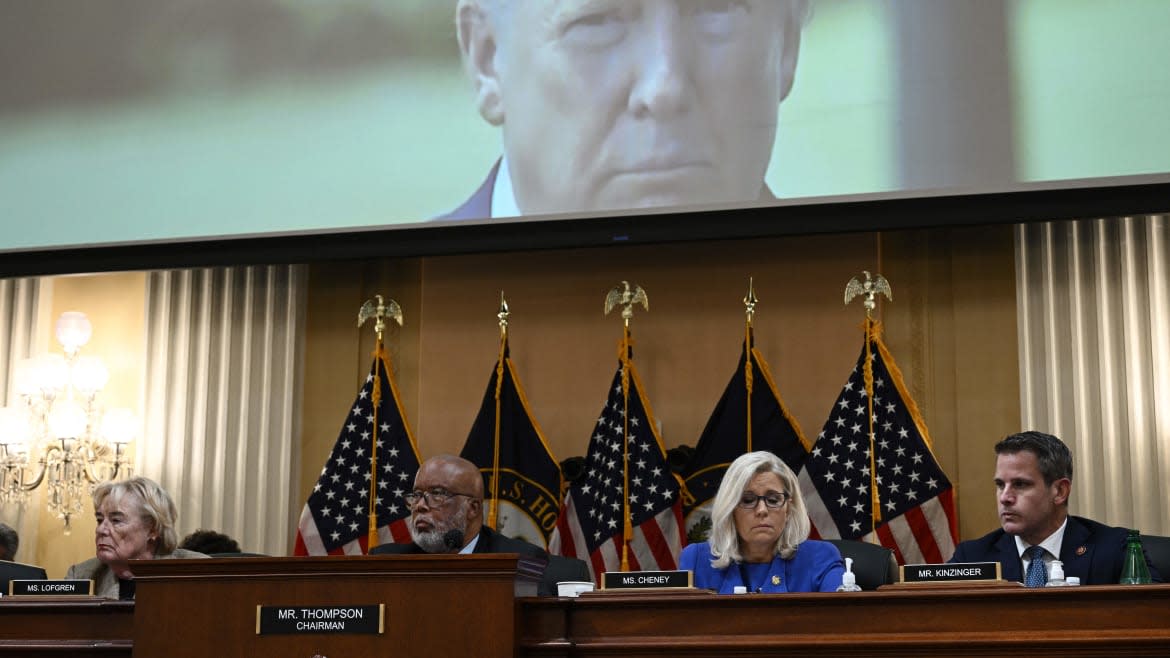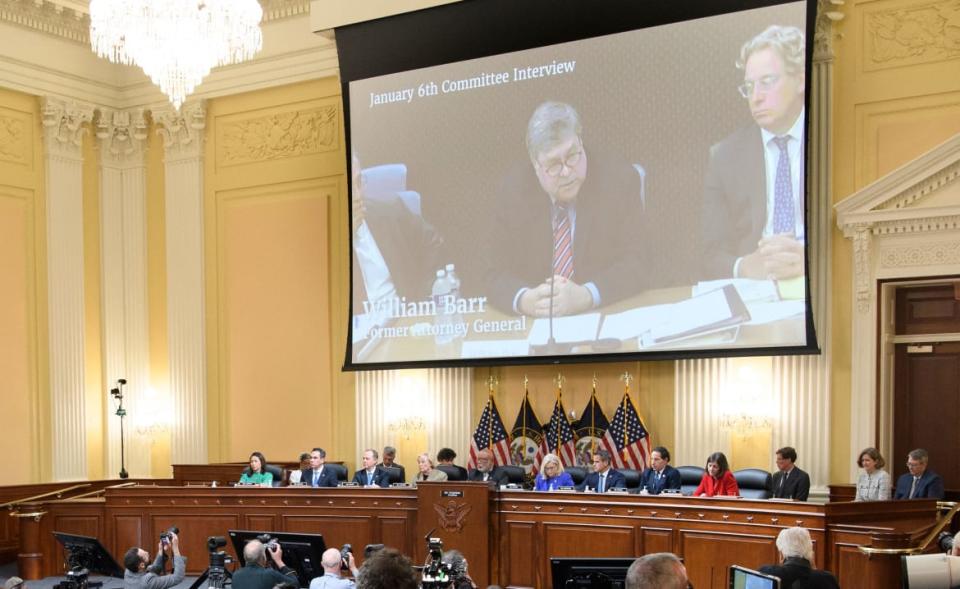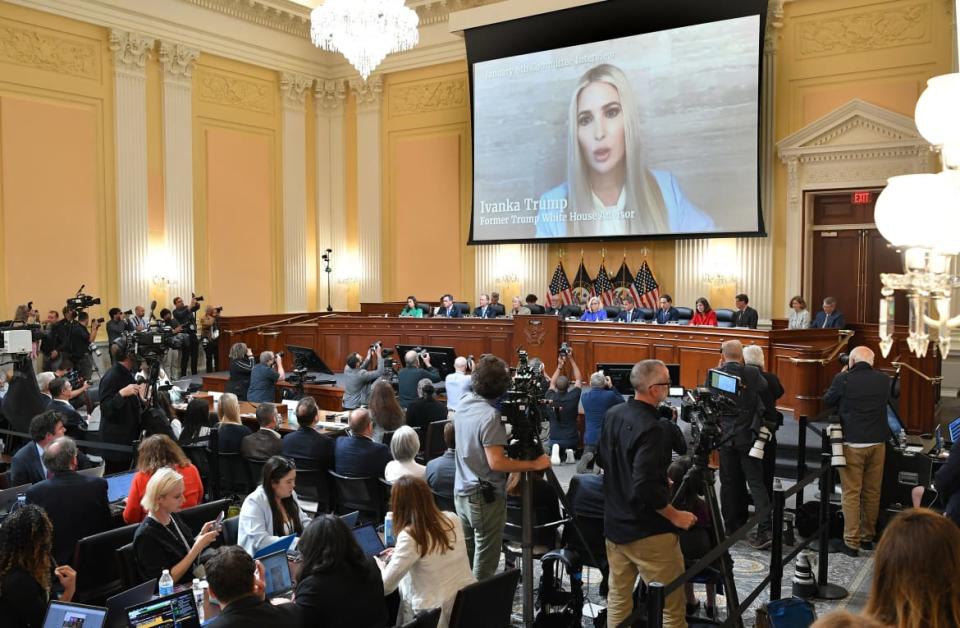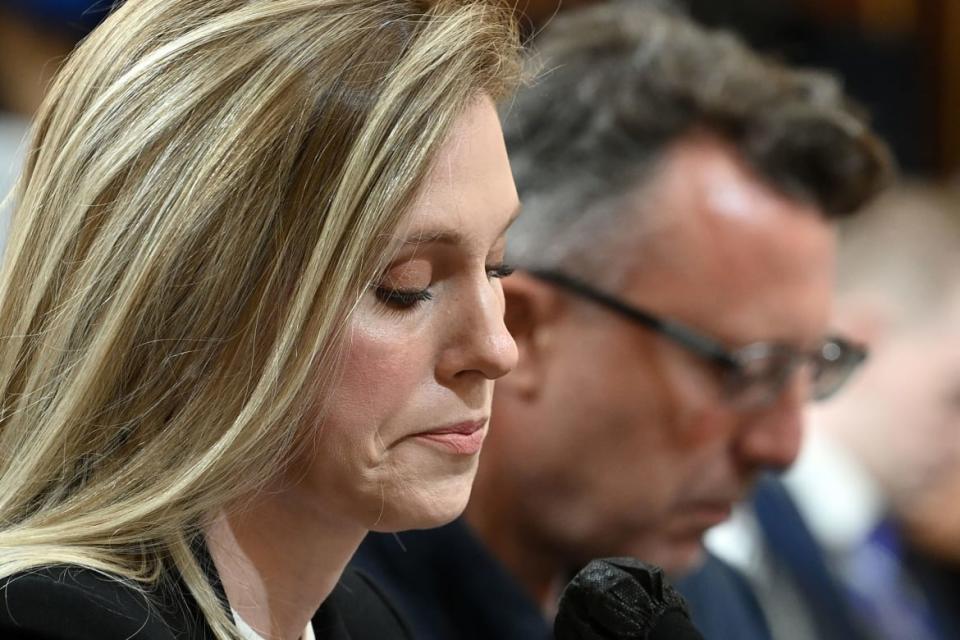‘Mike Pence Deserves It’: Jan. 6 Panel Reveals Trump’s Dark Desire

- Oops!Something went wrong.Please try again later.
- Oops!Something went wrong.Please try again later.
- Oops!Something went wrong.Please try again later.
- Oops!Something went wrong.Please try again later.
- Oops!Something went wrong.Please try again later.
- Oops!Something went wrong.Please try again later.
What was expected to be a largely perfunctory beginning to the Jan. 6 Committee’s historic hearings started with a few bombshells and a handful of heartbreaking moments.
Less than 20 minutes into the hearing, ranking Republican on the panel—Rep. Liz Cheney (R-WY)—revealed that, when then-President Donald Trump heard insurrectionists were calling to hang his vice president, Trump had an incredible reaction.
“Maybe our supporters have the right idea,” Trump said, according to Cheney. “Mike Pence deserves it.”
That was the message that Trump aides relayed to the Jan. 6 Committee, and it was just one of the incredible disclosures the panel made Thursday night during its first and historic hearing.

A video image of then Attorney General William Barr is seen on a screen during the hearing.
Chairman Bennie Thompson (D-MS) also revealed during his opening statement that Trump’s own attorney general, Bill Barr, told the Jan. 6 Committee that he quit at the tail-end of the administration because he could no longer sit idly by while the nation’s leader plotted to stay in power based on lies of electoral fraud.
“I made it clear I did not agree with the idea the election was stolen, which... I told the president was bullshit,” Barr said, leaning back in a chair during a videotaped deposition.
The committee also played snippets of previously unreleased video interviews with Trump aides, including his daughter Ivanka Trump, to prove that Trump knew his claims of election fraud were lies; he had been told repeatedly that he had lost fairly.
WATCH: Attorney General Barr declares that Donald Trump lost the Presidential election in 2020.
There is no doubt that the American people voted Trump out of office and the Select Committee has found no evidence of election fraud. pic.twitter.com/qa5qNyMXqS— January 6th Committee (@January6thCmte) June 10, 2022
Trump campaign spokesman Jason Miller recalled how the campaign’s top data expert, Matt Oczkowski, spoke to Trump himself and “delivered pretty blunt terms that he was going to lose.” Alex Cannon, a Trump Organization lawyer who later joined the candidate’s campaign, remembered telling White House Chief of Staff Mark Meadows “we weren’t finding anything that would be sufficient to change the results in any of the key states”—to which Meadows responded, “So there's no there there.”
Even Ivanka Trump told the committee that Barr’s assertion that there was no widespread fraud swayed her personally.
“It affected my perspective. I respect Attorney General Barr, so I accepted what he was saying,” she told the committee during a videotaped virtual interview.

Ivanka Trump’s testimony is played on screen during the hearing.
Cheney also made clear that this investigation turned the spotlight on some fellow members of Congress, revealing that Rep. Scott Perry (R-PA)—now the chairman of the House Freedom Caucus—and “several” other Republicans sought a pardon from Trump for his role in the attack on Jan. 6.
Cheney called out her fellow Republicans who continue to profess loyalty to the former president, saying, "There will come a day when Donald Trump is gone. But your dishonor will remain."
Thompson kicked off the proceedings by stressing that “it was domestic enemies of the constitution who stormed ... and occupied the Capitol.” And he put the blame squarely on Trump, saying the attack was “the culmination of an attempted coup.”
“He spurred a mob of domestic enemies of the constitution to march down the capital and subvert American democracy,” he said.
"Those who invaded our Capitol and battled law enforcement for hours were motivated by what President Trump had told them.
President Trump summoned the mob, assembled the mob and lit the flame of this attack." -Vice Chair @RepLizCheney pic.twitter.com/GOeynxo1Tm— January 6th Committee (@January6thCmte) June 10, 2022
The committee on Thursday night also shed more light on Trump’s inaction and the role of the military in failing to intervene and defend the Capitol building. Cheney said Trump did not call the Secretary of Defense, nor the Attorney General, nor the Secretary of Homeland Security. “Trump gave no order to deploy the National Guard… no effort to work with the Department of Justice to deploy law enforcement assets.”
Instead, it was Pence who assumed the responsibility to defend legislators by demanding that the military intervene.
The committee played a video of testimony from top military official General Mark Milley, chairman of the Joint Chiefs of Staff, who testified that he had “two to three calls” with Pence.
“He was very animated, very direct, very firm… get the military there, get the guard down here, put down this situation,” he said.
LISTEN: Committee plays audio of Joint Chiefs of Staff Gen. Mark Milley's description of his discussion with White House Chief of Staff Mark Meadows on Jan. 6.
"He said, we have to kill the narrative that the vice president is making all the decisions." https://t.co/W2f3oCDYwh pic.twitter.com/kyGpmEC5u2— ABC News (@ABC) June 10, 2022
And instead of addressing the actual threat that day, the White House apparently attempted to cover up Trump’s inaction by trying to coerce Milley—a military official who should have never been subject to politics—to frame Trump as still in charge.
Milley recalled being told by Meadows that “we have to kill the narrative that the vice president is making all the decisions. We need to establish the narrative that you know that the president is still in charge and things are steady or stable or words to that effect.”
The committee isn’t just investigating the attack on the Capitol; the investigation is also about the multi-layered attempt from former President Donald Trump and his loyalists to keep him in office after losing the 2020 election.
Thursday’s presentation marks the first of roughly half a dozen public hearings in which the committee will reveal its findings. The committee will show what it has learned on a number of fronts: Trump’s role in what’s been described as an attempted coup, the plot by his loyalists and advisers to overturn votes in several states, the intense campaign to pressure then-Vice President Mike Pence to misuse his role and refuse to certify electoral college results, and the mob’s insurrection.
Committee aides told reporters Thursday’s hearing would focus on documenting “the reality of that violence and how horrific it was” by presenting “previously unseen” video and audio of the way the crowd attempted to occupy the seat of Congress.
— January 6th Committee (@January6thCmte) June 10, 2022
The panel is telling the broader story about what happened that day, something the Justice Department has been quietly doing in hundreds of prosecutions in federal courtrooms as it pursues criminal charges against the insurrectionists who pummeled police officers, broke windows and doors to illegally enter the Capitol building, ransacked politicians’ offices, took furniture and electronic devices, searched for members of Congress with kidnapping tools, and erected gallows outside.
Even before the onslaught of new information Thursday night, Democrats wanted to maximize visibility of the hearing, hoping to remind the public of the deadly event. Outside groups organized watch parties nationwide, including one just outside the hearing on a lawn of the Capitol grounds.
The event, put together by a coalition of Democratic organizations, had viewers seated picnic style on blankets and chairs as the committee’s audio was blasted out. By and large, viewers appeared gripped by the testimony, cheering at committee-members’ speeches and digs on the former president.
The Jan. 6 Committee Can’t Convict Trump—but It Could Help Bankrupt Him
Only once did a mass number of folks look away from the screen during the early half of the hearing: when the free ice cream arrived, supplied with liberal brand Ben & Jerry’s.
This effort has faced an uphill battle from the start. Plans by House Speaker Nancy Pelosi (D-CA) to initiate a formal, independent commission—like the 9/11 Commission put together after the terrorist attacks on U.S. soil by Al-Qaeda—failed when Republicans refused to support its creation in May 2021.
Instead, House Democrats forged ahead by creating a temporary investigative committee with nine members.
When Minority Leader Kevin McCarthy (R-CA) volunteered five Trump loyalists for the panel, Pelosi rejected two of his picks—Rep. Jim Jordan (R-OH) and Rep. Jim Banks (R-IN)—citing their role in undermining the election. In response, McCarthy pulled all of his selections. And in response to that move, Pelosi offered the positions in July to two other Republicans who were willing to put aside the party’s growing adherence to the MAGA movement: Cheney and Rep. Adam Kinzinger (R-IL).
The hearing ended with moving testimony from two witnesses: documentarian Nick Quested and Capitol Police officer Caroline Edwards.
Quested, a British filmmaker who got exclusive access to the Proud Boys leadership before and during the insurrection, spoke about his deep concern about how "the atmosphere seemed to be much darker" as the gang made its way toward police.
Meanwhile, Edwards relived the way she struggled to hold bike racks together to block those Proud Boys—only to have them viciously shove her back. She slammed her head against concrete stairs and passed out with a traumatic brain injury. When she regained consciousness, she stood guard alongside fellow cop Brian Sicknick—and was with him when he suffered devastating wounds shortly before he died.
“What I saw was just a war scene,” Edwards said. “It was something like I'd seen out of movies. I couldn't believe my eyes. There were officers on the ground. They were bleeding. They were throwing up. I saw friends with blood all over their faces. I was slipping in people's blood. I was catching people as they fell. It was carnage. It was chaos.”
“I can't even describe what I saw,” she continued. “Never in my wildest dreams did I think that, as a police officer—as a law enforcement officer—I would find myself in a battle,” she said, shaking in her seat.

Nick Quested (right) testifies alongside Capitol Police Officer Caroline Edwards.
She described seeing Officer Sicknick’s “ghostly pale” face after he was sprayed with caustic chemicals. He held his head in his hands, she recalled, and she said she was worried because pepper spray typically causes someone’s face to turn red, but Sicknick’s face was different.
“He turned about as pale as a sheet of paper,” she said, holding up a blank white piece of paper.
Ursula Perano and Matt Fuller contributed to this report.
Get the Daily Beast's biggest scoops and scandals delivered right to your inbox. Sign up now.
Stay informed and gain unlimited access to the Daily Beast's unmatched reporting. Subscribe now.

